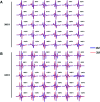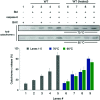Accessing local structural disruption of Bid protein during thermal denaturation by absorption-mode ESR spectroscopy
- PMID: 35548640
- PMCID: PMC9087001
- DOI: 10.1039/c8ra06740f
Accessing local structural disruption of Bid protein during thermal denaturation by absorption-mode ESR spectroscopy
Abstract
Bid is a requisite protein that connects death receptors to the initiation of mitochondrial-dependent apoptosis. Its structure was determined more than a decade ago, but its structure-function relationship remains largely unexplored. Here we investigate the thermostability of Bid protein and explore how the death-promoting function of Bid is affected by thermally-induced unfolding. First, we show by circular dichroism (CD) spectroscopy that Bid remains partially folded at high temperatures (350-368 K), and that the thermal unfolding of Bid is irreversible and accompanied with intermolecular associations that lead to protein aggregation. In 3 M GdnHCl, the onset of unfolding can, however, be conveniently observed at much lower temperatures around 320 K. We employ pulsed ESR dipolar spectroscopy to show that the structure of Bid remains almost unchanged between 0 and 3 M GdnHCl before thermal denaturation. More than 30 single-labeled Bid mutants are studied using the peak-height analysis method based on ESR absorption spectroscopy, in the temperature range of 300-345 K. The ESR results provide site-specific information about the temperature dependence of the local environment of Bid, thus enabling the discrimination between the onsets of unfolding and aggregation for respective sites. Consequently, we map out the local thermostability over the Bid structure and identify a new interface between helices 3, 6, and 8 as the beginning of structural unfolding. This study also investigates the apoptotic activity of the thermally-induced Bid aggregates and shows that Bid retains the death-promoting function even when unfolded and aggregated. The applicability of the new ESR absorption peak-height method is demonstrated for protein thermostability.
This journal is © The Royal Society of Chemistry.
Conflict of interest statement
There are no conflicts of interest to declare.
Figures







Similar articles
-
Perturbation of a tertiary hydrogen bond in barstar by mutagenesis of the sole His residue to Gln leads to accumulation of at least one equilibrium folding intermediate.Biochemistry. 1995 Feb 7;34(5):1702-13. doi: 10.1021/bi00005a027. Biochemistry. 1995. PMID: 7849030
-
Artocarpus hirsuta lectin. Differential modes of chemical and thermal denaturation.Eur J Biochem. 2002 Mar;269(5):1413-7. doi: 10.1046/j.1432-1033.2002.02789.x. Eur J Biochem. 2002. PMID: 11874455
-
Thermal and urea-induced unfolding of the marginally stable lac repressor DNA-binding domain: a model system for analysis of solute effects on protein processes.Biochemistry. 2003 Feb 25;42(7):2202-17. doi: 10.1021/bi0270992. Biochemistry. 2003. PMID: 12590610
-
Thermodynamics of denaturation of barstar: evidence for cold denaturation and evaluation of the interaction with guanidine hydrochloride.Biochemistry. 1995 Mar 14;34(10):3286-99. doi: 10.1021/bi00010a019. Biochemistry. 1995. PMID: 7880824
-
Prediction and analysis of structure, stability and unfolding of thermolysin-like proteases.J Comput Aided Mol Des. 1993 Aug;7(4):367-96. doi: 10.1007/BF02337558. J Comput Aided Mol Des. 1993. PMID: 8229092 Review.
Cited by
-
Electrostatic Clamp and Loop Dynamics Dictate Caspase-8 Cleavage of the Apoptotic Protein Bid.J Phys Chem Lett. 2025 Jul 31;16(30):7522-7529. doi: 10.1021/acs.jpclett.5c01976. Epub 2025 Jul 18. J Phys Chem Lett. 2025. PMID: 40679149 Free PMC article.
-
Stepwise activation of the pro-apoptotic protein Bid at mitochondrial membranes.Cell Death Differ. 2021 Jun;28(6):1910-1925. doi: 10.1038/s41418-020-00716-5. Epub 2021 Jan 18. Cell Death Differ. 2021. PMID: 33462413 Free PMC article.
-
Decoupling Global and Local Structural Changes in Self-aminoacylating Ribozymes Reveals the Critical Role of Local Structural Dynamics in Ribozyme Activity.JACS Au. 2025 May 9;5(5):2172-2185. doi: 10.1021/jacsau.5c00146. eCollection 2025 May 26. JACS Au. 2025. PMID: 40443886 Free PMC article.
References
LinkOut - more resources
Full Text Sources
Miscellaneous

